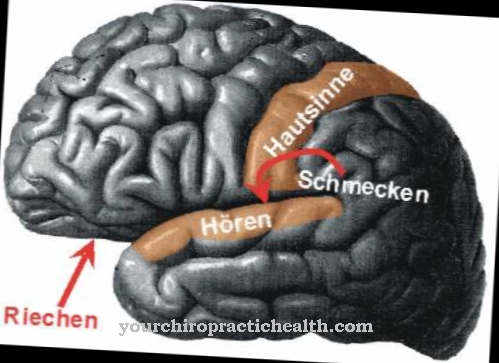The Throat muscles consist of skeletal muscles, i.e. so-called striated muscles. Functionally they are made up of three throat constricters and three throat lifters.
The throat (pharynx) is the foremost part of the digestive tract connected to the mouth. It is lined with mucous membrane and is subdivided into the nasal pharynx, mouth and pharynx. Colloquially, the term "upper respiratory tract" is used for the throat.
What are the throat muscles?
During the process of swallowing, the throat muscles play a crucial role in that they lift the throat and thus close the larynx so that no food gets into the windpipe. It is also significantly involved in transporting food from the throat to the esophagus.
However, many other muscles are involved in the actual swallowing, so that one cannot speak of the one “swallowing muscle”. The throat constricters are large, flat muscles with fibers arranged in a fan shape. Their job is to narrow the throat when swallowing. A distinction is made between upper, middle and lower throat constricters. The pharyngeal lifters, on the other hand, are relatively small and weak muscles. They are responsible for lifting the throat and larynx. The throat includes the tonsils, collections of lymphatic tissue.
The external carotid artery is responsible for the blood supply to the throat. The IX. and X. cranial nerve (glossopharyngeal nerve, vagus nerve). The pharynx is also innervated by the 5th cranial nerve (nervus trigenimus).If the glossopharyngeal nerve fails, swallowing paralysis occurs, which is one of the most important diseases of the throat. Pharyngitis (inflammation of the throat) and pharyngeal diphtheria are also known. The throat is also a preferred location for various carcinomas.
Anatomy & structure
The activity of the throat muscles is closely related to pathological snoring and a possible occlusion of the upper airways (sleep apnea). These two sleep-related disorders can in some cases be reduced considerably with organized training of the muscles of the palate, tongue and throat.
These exercises help to noticeably increase the tension of the entire airway muscles. Because sleep apnea, for example, arises from the relaxation of the muscle groups in question at night. Muscle tension in the throat also decreases when snoring, which narrows the upper airways. The result is the typical fluttering noises that make snoring worse. Often the tongue falls back and leads to increased snoring.
In contrast, daily singing, for example, trains the human voice and has been shown to have a positive influence on strengthening the throat muscles. Thus, the intensity and volume of snoring and the severity of sleep apnea could be reduced. Special training programs for the palate muscles have also been used successfully for a long time. For example, snoring can be reduced if the tongue is pressed firmly against the lower jaw in the closed mouth for a few minutes a day. It is also recommended to hold a suitable object between your teeth for ten minutes a day and bite firmly.
Function & tasks
Snoring and sleep apnea are usually mutually dependent. It has been observed in patients with sleep apnea that periods of snoring alternate with prolonged cessation of breathing. When snoring, the upper airways remain open, while in the state of apnea they can temporarily close completely. This state can last for a few seconds or a good minute.
As a rule, it is ended by a so-called wake-up reaction, which protects those affected from possible suffocation. The slackening of the throat muscles, which is the reason for this dangerous condition, mainly occurs in men over the age of 40 and in overweight people. Due to the nocturnal unrest, you often feel sleepy on the following day, quickly suffer from exhaustion and lack of concentration.
The so-called microsleep, which is often causally related to nightly sleep disorders, is feared among motorists. Many people suffer from severe and persistent headaches. It is not uncommon for them to develop into depressive states. Under certain circumstances, sexual dysfunction, a strong urge to urinate at night and excessive sweating while sleeping can also become noticeable.
You can find your medication here
➔ Medicines for sore throats and difficulty swallowingDiseases
The weakness of the throat muscles leads to a greater or lesser degree of oxygen deficiency in the organs of the body because of the breathing problems of many people affected. In the long term, high blood pressure and cardiac arrhythmias develop from this in many cases.
It cannot be ruled out that later strokes are also directly related to these irregularities. In overweight people, increased deposits of fatty substances in the throat and tongue are also often the cause of sleep apnea or heavy snoring. Large or enlarged tonsils can also lead to throat constriction. The same applies to changes in the tongue and an overly voluminous uvula. Last but not least, various obstructions of the airways in the nose are possibly responsible for the development of sleep apnea. A slack throat muscles, on the other hand, are favored by excessive alcohol consumption and the occasional use of medication such as sleeping pills.
If moderation does not lead to success, every patient has the option of so-called continuous positive overpressure therapy. With the help of a nasal mask, room air is supplied with it, which prevents the upper airways from closing. By creating a permanently constant air pressure, night sleep and breathing can move back to normal.












.jpg)






.jpg)

.jpg)




.jpg)

